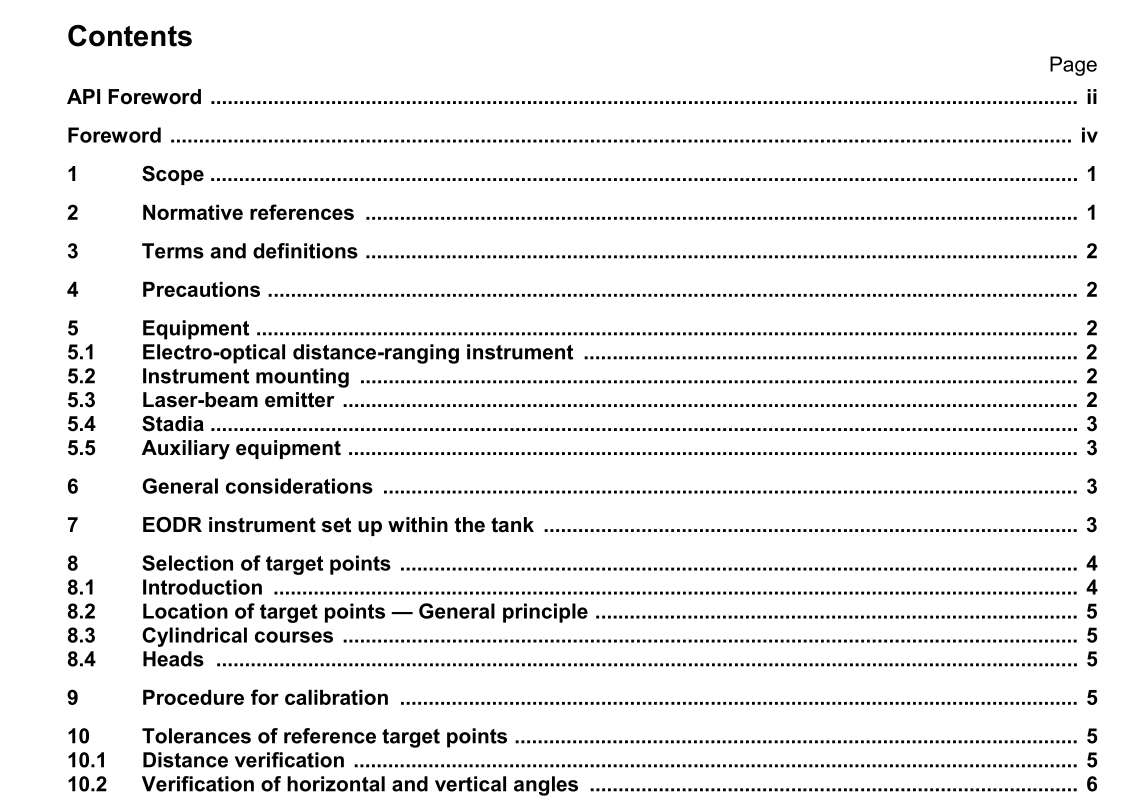API MPMS 2.2F pdf download

API MPMS 2.2F pdf download.Petroleum and liquid petroleum products — Calibration of horizontal cylindrical tanks
6 General considerations
6.1 The EODR instrument shall be maintained so that the values of their measurement specifications do not exceed the values given in this part of ISO 12917. 6.2 Tanks shall only be calibrated after they have been filled at least once with a liquid of density equal to or greater than that of the liquid which they will hold when in use, and at a pressure greater than the pressure at which they will operate when in service. NOTE The hydrostatic or pressure test applied to new tanks will satisfy this requirement in most cases. 6.3 Calibration shall be carried out without interruption. 6.4 The EODR instrument shall be verified prior to calibration. The accuracy of the distance-measuring unit as well as the angle-measuring unit shall be verified using the procedures recommended by the manufacturer (e.g. a stadia or reference laser may be used for distance measurement). The procedures given in ISO 7507-4:1995, annex A should be used for the verification of field equipment. 6.5 The tank shall be free from vibration and airborne dust particles. NOTE The floor of the tank should be as free as possible from debris, dust and loose scale. 6.6 Lighting, when required, shall be placed within the tank so as not to interfere with the operation of the EODR instrument.
7 EODR instrument set up within the tank
7.1 The number and locations of the instrument stations shall be determined in order not to exceed incidence-angle limitations of equipment (see normative annex A). A typical minimum angle may be 10 gon. If more than one station is necessary, survey traverse techniques should be used to move from one station to the other and the procedure in this subclause repeated. 7.2 The instrument shall be set up with care, particularly in the horizontal and vertical axes and according to the procedure and instructions given by the manufacturer. 7.3 The instrument shall be set up so as to be stable and free from external vibrations. If necessary, the tank shell, in the vicinity of the instrument, shall be made firm and steady by placing heavy weights in the area. The legs of the tripod on which the instrument is mounted may be steadied using suitable devices, such as magnetic bearers, to prevent slippage on the tank bottom.7.4 The sighting lines from the instrument to the tank shell shall not be obstructed. 7.5 The instrument shall be switched on and brought to operating temperature for at least the minimum time recommended by the manufacturer. 7.6 If the distance-measurement part is separate, parallax adjustment is made at the start. The distance optical beam and laser beams are adjusted after temperature equilibrum, to ensure zero parallax, and then locked in position. 7.7 Select one or two reference target points. The reference target points should be approximately 100 gon apart and preferably on the same horizontal plane as the instrument.
8 Selection of target points
8.2 Location of target points — General principle Target points shall be located on each surface, randomly but distributed over the entire surface. No target points shall be positioned within 300 mm of a welded seam or stiffener. NOTE It is not a requirement of this method that any particular point be used as a target point 8.3 Cylindrical courses A minimum of 16 target points per course in tanks of diameter less than 3 m, and a minimum of 24 target points per course in tanks of diameter 3 m or greater, shall be sighted. The uncertainty of calibration will be reduced if the number of target points is greater than the minimum specified. 8.4 Heads 8.4.1 Flat end, elliptical, spherical head, conical head A minimum of 50 target points, randomly but evenly distributed over the surface, shall be sighted. The uncertainty of the calibration will be reduced if a greater number of target points is used. 8.4.2 Knuckle-dished end (head) A minimum of 16 target points, randomly but evenly distributed over the surface, shall be sighted. The uncertainty of the calibration will be reduced if a greater number of target points is used.









